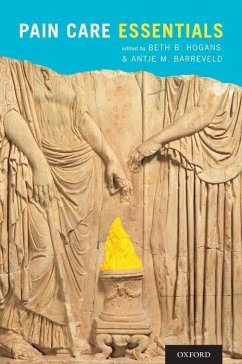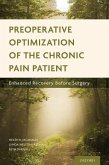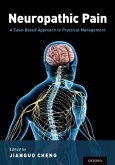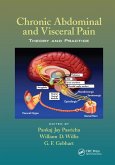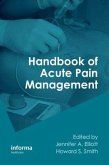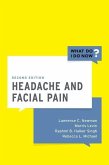Pain Care Essentials
Herausgeber: Hogans, Beth B; Barreveld, Antje M
Schade – dieser Artikel ist leider ausverkauft. Sobald wir wissen, ob und wann der Artikel wieder verfügbar ist, informieren wir Sie an dieser Stelle.
Pain Care Essentials
Herausgeber: Hogans, Beth B; Barreveld, Antje M
- Broschiertes Buch
- Merkliste
- Auf die Merkliste
- Bewerten Bewerten
- Teilen
- Produkt teilen
- Produkterinnerung
- Produkterinnerung
This book is designed to prepare young clinicians to assess and treat a wide variety of pain conditions in a manner that balances competence and compassion, incorporating coordinated elements of pharmacological and non-pharmacological therapies.
Andere Kunden interessierten sich auch für
![Preoperative Optimization of the Chronic Pain Patient Preoperative Optimization of the Chronic Pain Patient]() Heath B McAnallyPreoperative Optimization of the Chronic Pain Patient82,99 €
Heath B McAnallyPreoperative Optimization of the Chronic Pain Patient82,99 €![Neuropathic Pain Neuropathic Pain]() Neuropathic Pain189,99 €
Neuropathic Pain189,99 €![Chronic Abdominal and Visceral Pain Chronic Abdominal and Visceral Pain]() Chronic Abdominal and Visceral Pain80,99 €
Chronic Abdominal and Visceral Pain80,99 €![Handbook of Acute Pain Management Handbook of Acute Pain Management]() Handbook of Acute Pain Management100,99 €
Handbook of Acute Pain Management100,99 €![Headache and Facial Pain Headache and Facial Pain]() Lawrence NewmanHeadache and Facial Pain72,99 €
Lawrence NewmanHeadache and Facial Pain72,99 €![A Field Manual for Palliative Care in Humanitarian Crises A Field Manual for Palliative Care in Humanitarian Crises]() A Field Manual for Palliative Care in Humanitarian Crises54,99 €
A Field Manual for Palliative Care in Humanitarian Crises54,99 €![Spinal Interventions in Pain Management Spinal Interventions in Pain Management]() Karen SimpsonSpinal Interventions in Pain Management96,99 €
Karen SimpsonSpinal Interventions in Pain Management96,99 €-
This book is designed to prepare young clinicians to assess and treat a wide variety of pain conditions in a manner that balances competence and compassion, incorporating coordinated elements of pharmacological and non-pharmacological therapies.
Produktdetails
- Produktdetails
- Verlag: Oxford University Press
- Seitenzahl: 432
- Erscheinungstermin: 27. Januar 2020
- Englisch
- Abmessung: 231mm x 155mm x 23mm
- Gewicht: 703g
- ISBN-13: 9780199768912
- ISBN-10: 0199768919
- Artikelnr.: 58262104
- Herstellerkennzeichnung
- Libri GmbH
- Europaallee 1
- 36244 Bad Hersfeld
- gpsr@libri.de
- Verlag: Oxford University Press
- Seitenzahl: 432
- Erscheinungstermin: 27. Januar 2020
- Englisch
- Abmessung: 231mm x 155mm x 23mm
- Gewicht: 703g
- ISBN-13: 9780199768912
- ISBN-10: 0199768919
- Artikelnr.: 58262104
- Herstellerkennzeichnung
- Libri GmbH
- Europaallee 1
- 36244 Bad Hersfeld
- gpsr@libri.de
Dr. Beth B. Hogans, M.D., Ph.D. holds board certifications in Neurology, Clinical Electrophysiology, and Pain Medicine and is an experienced general and peripheral neurologist with a strong focus on providing patient-centered care. Dr. Hogans teaches medical students about pain management at Johns Hopkins School of Medicine where she is an associate professor of neurology. She is a 2018 recipient of the Osler Attending Teaching Preceptor designation in the Johns Hopkins Neurology Department. Antje Barreveld, MD is Assistant Professor of Anesthesiology at Tufts University School of Medicine, Medical Director of Pain Management Services, Director of Education and Outreach for the Substance Use Services, and Anesthesiologist with Commonwealth Anesthesia Associates at Newton-Wellesley Hospital in Newton, MA. Dr. Barreveld is also a Clinical Researcher at Harvard Medical School in the Department of Anesthesiology, Perioperative and Pain Medicine at Brigham and Women's Hospital in Boston, MA. Her clinical, leadership, and research interests are in pain management education, chronic pelvic pain in men and women, acute and chronic postoperative pain, and safe practices in co-managing pain and addiction. Her goal is to inspire interprofessional students to recognize the joy of alleviating suffering - and that safe, effective pain management is an achievable goal for all new clinicians.
* Introduction
* Part I: The Multidimensionality of Pain: Neurobiology, Scope, and
Impact
* 1. Pain pathways: Structural organization and development
* 2. Nociceptive processing: Neurochemistry and neurophysiology
* 3. The impact of pain: Epidemiology, economics, cultural influences,
ethics
* 4. The appraisal of pain: Measurement, classification, and
nomenclature
* 5. The spectrum of pain experience
* Part II: Clinical Skills in the Assessment and Care of Pain
* 6. Clinical assessment of pain: The pain narrative, examination,
clinical stance
* 7. Diagnostic reasoning in the pain-focused encounter
* 8. Professionalism in pain care: Compassion, decision-making,
behavior change difficult conversations, ethical standards, pain
self-management
* Part III: Pain Treatments and Approaches to Management
* 9. Pharmacological treatments I: Standard systemic analgesic agents
* 10. Pharmacological treatments II: Anti-depressants,
anti-convulsants, etc.
* 11. Interventional and surgical management of pain
* 12. Rehabilitational approaches to pain and applications in
outpatient practice
* Part IV: Pain Care in Clinical Context
* 13. Pain emergencies and life-threatening complications of pain
treatments
* 14. Acute pain: Peri-operative, trauma-related, and obstetric pain
* 15. Urgent pain problems (migraine, acute lower back pain, etc)
* 16. Common chronic pain-associated conditions (neck pain, lower back
pain, neuropathy)
* 17. Extremes of pain: CRPS, trigeminal neuralgia, congenital pain
insensitivity
* 18. Pediatric pain
* 19. Pain in older patients
* 20. Pain, addiction, and psychiatric illness
* Appendices: Commonly used pain medications; Adjustments for liver and
renal failure; Opioid conversion table; Exam template; Integrated
back pain flow diagram
* Part I: The Multidimensionality of Pain: Neurobiology, Scope, and
Impact
* 1. Pain pathways: Structural organization and development
* 2. Nociceptive processing: Neurochemistry and neurophysiology
* 3. The impact of pain: Epidemiology, economics, cultural influences,
ethics
* 4. The appraisal of pain: Measurement, classification, and
nomenclature
* 5. The spectrum of pain experience
* Part II: Clinical Skills in the Assessment and Care of Pain
* 6. Clinical assessment of pain: The pain narrative, examination,
clinical stance
* 7. Diagnostic reasoning in the pain-focused encounter
* 8. Professionalism in pain care: Compassion, decision-making,
behavior change difficult conversations, ethical standards, pain
self-management
* Part III: Pain Treatments and Approaches to Management
* 9. Pharmacological treatments I: Standard systemic analgesic agents
* 10. Pharmacological treatments II: Anti-depressants,
anti-convulsants, etc.
* 11. Interventional and surgical management of pain
* 12. Rehabilitational approaches to pain and applications in
outpatient practice
* Part IV: Pain Care in Clinical Context
* 13. Pain emergencies and life-threatening complications of pain
treatments
* 14. Acute pain: Peri-operative, trauma-related, and obstetric pain
* 15. Urgent pain problems (migraine, acute lower back pain, etc)
* 16. Common chronic pain-associated conditions (neck pain, lower back
pain, neuropathy)
* 17. Extremes of pain: CRPS, trigeminal neuralgia, congenital pain
insensitivity
* 18. Pediatric pain
* 19. Pain in older patients
* 20. Pain, addiction, and psychiatric illness
* Appendices: Commonly used pain medications; Adjustments for liver and
renal failure; Opioid conversion table; Exam template; Integrated
back pain flow diagram
* Introduction
* Part I: The Multidimensionality of Pain: Neurobiology, Scope, and
Impact
* 1. Pain pathways: Structural organization and development
* 2. Nociceptive processing: Neurochemistry and neurophysiology
* 3. The impact of pain: Epidemiology, economics, cultural influences,
ethics
* 4. The appraisal of pain: Measurement, classification, and
nomenclature
* 5. The spectrum of pain experience
* Part II: Clinical Skills in the Assessment and Care of Pain
* 6. Clinical assessment of pain: The pain narrative, examination,
clinical stance
* 7. Diagnostic reasoning in the pain-focused encounter
* 8. Professionalism in pain care: Compassion, decision-making,
behavior change difficult conversations, ethical standards, pain
self-management
* Part III: Pain Treatments and Approaches to Management
* 9. Pharmacological treatments I: Standard systemic analgesic agents
* 10. Pharmacological treatments II: Anti-depressants,
anti-convulsants, etc.
* 11. Interventional and surgical management of pain
* 12. Rehabilitational approaches to pain and applications in
outpatient practice
* Part IV: Pain Care in Clinical Context
* 13. Pain emergencies and life-threatening complications of pain
treatments
* 14. Acute pain: Peri-operative, trauma-related, and obstetric pain
* 15. Urgent pain problems (migraine, acute lower back pain, etc)
* 16. Common chronic pain-associated conditions (neck pain, lower back
pain, neuropathy)
* 17. Extremes of pain: CRPS, trigeminal neuralgia, congenital pain
insensitivity
* 18. Pediatric pain
* 19. Pain in older patients
* 20. Pain, addiction, and psychiatric illness
* Appendices: Commonly used pain medications; Adjustments for liver and
renal failure; Opioid conversion table; Exam template; Integrated
back pain flow diagram
* Part I: The Multidimensionality of Pain: Neurobiology, Scope, and
Impact
* 1. Pain pathways: Structural organization and development
* 2. Nociceptive processing: Neurochemistry and neurophysiology
* 3. The impact of pain: Epidemiology, economics, cultural influences,
ethics
* 4. The appraisal of pain: Measurement, classification, and
nomenclature
* 5. The spectrum of pain experience
* Part II: Clinical Skills in the Assessment and Care of Pain
* 6. Clinical assessment of pain: The pain narrative, examination,
clinical stance
* 7. Diagnostic reasoning in the pain-focused encounter
* 8. Professionalism in pain care: Compassion, decision-making,
behavior change difficult conversations, ethical standards, pain
self-management
* Part III: Pain Treatments and Approaches to Management
* 9. Pharmacological treatments I: Standard systemic analgesic agents
* 10. Pharmacological treatments II: Anti-depressants,
anti-convulsants, etc.
* 11. Interventional and surgical management of pain
* 12. Rehabilitational approaches to pain and applications in
outpatient practice
* Part IV: Pain Care in Clinical Context
* 13. Pain emergencies and life-threatening complications of pain
treatments
* 14. Acute pain: Peri-operative, trauma-related, and obstetric pain
* 15. Urgent pain problems (migraine, acute lower back pain, etc)
* 16. Common chronic pain-associated conditions (neck pain, lower back
pain, neuropathy)
* 17. Extremes of pain: CRPS, trigeminal neuralgia, congenital pain
insensitivity
* 18. Pediatric pain
* 19. Pain in older patients
* 20. Pain, addiction, and psychiatric illness
* Appendices: Commonly used pain medications; Adjustments for liver and
renal failure; Opioid conversion table; Exam template; Integrated
back pain flow diagram

